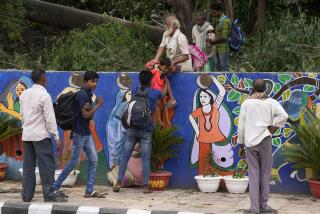Delhi, on the Nigel express
“Welcome to deepest, darkest Delhi, where no white man doth tread,” Nigel Hankin said in mock cadences. His snowy eyebrows arched as his left foot perched on a dirty stair. I peered up the ancient passageway. It was indeed a path straight to darkness, a grim corridor into the unknown.
My uncle Mike and I had retained the octogenarian Englishman as our guide, asking him to show us the Delhi most tourists miss. So, gulping, I ascended, my feet feeling for each foothold, my left hand skittering along a grimy wall. I counted 23 steps, wrapped my hand around a corner, turned left and saw — way up there — a square of light.
It led, finally, to the second-floor balcony of a crumbling three-story building. Looking out, I could see what was once an airy courtyard ringed with filigreed balustrades was now a teeming shantytown.
Minutes later, we plunged back into Delhi’s streets, long tunnels barely wide enough for one person. Wiry men, bent under burlap sacks and wooden crates, bore down and drove us headlong into cramped stalls.
Suddenly, all around me was a great gasping, choking, coughing. The porters donned kerchiefs, bandit-style. Soon I too was sneezing and struggling for breath.
We had arrived at the capsicum, or pepper, market, and in the press of hot bodies and red pepper I felt my senses seize up. All I could think of was escaping this corner of the planet. Now.
Meet your guide
Early that morning, when we had met our aging expatriate guide, we had hardly anticipated the pungent day ahead.“Did you have a plan for the day?” Nigel had asked in starchy British syllables, as he fiddled with a worn black satchel.
“We’re putting ourselves in your hands,” I gamely replied to the man whom diplomat friends had called Delhi’s best-kept secret.
We’d come from California for a wedding in March but had little interest in another day of shopping with my aunt and cousins. The intrigue in tracking Nigel down and booking him for a day held much more appeal.
Friends at the American Embassy had told me to ask the guards at the Mughal Gate of the British High Commission for “Nigel Hankin’s diary” and then find an empty page and request a date. (Nigel has no telephone, and the British High Commission does not take calls for him.) To confirm, I had to return another day to check the journal.
On the day of the confirmed appointment, we arrived at 8 a.m. with the required car and driver. The additional requirements: 2,000 rupees (about $45), plus lunch for Nigel and the party at a restaurant of his choosing.
He was well over 6 feet tall and stooped and was dressed in dingy brown slacks, plaid shirt, wool vest and running shoes. His ragged white hair gave him the air of an elder who lacked someone to watch after him.
Nigel quickly commandeered the front seat of our hired car, barking “Dahine! (Right!)” in Hindi to the bemused driver and bending his wrinkled hand. “Seedha! (Straight!)” he commanded as we entered one of the city’s countless roundabouts.
“The word ‘bungalow’ comes from the Hindi bangla, or ‘house in the Bengali style,’ ” Nigel said as we approached a white stucco cube set in a lawn edged with high trees and potted roses. Then we entered the cool rooms of Indira Gandhi’s former home, now a museum.
Photos, news articles and personal effects recalled highlights in the life of the four-term prime minister, but it was Nigel who added details of her roots in Kashmir, the family mansion in Allahabad and the privileges showered on her, the daughter of India’s first democratic leader, Jawaharlal Nehru. Nigel became especially animated describing the controversial policies she forged in the study, the only room preserved as Gandhi left it.
Also preserved was the peach-colored, bloodstained sari she wore on Oct. 31, 1984. “She was walking down a garden pathway headed for an interview with Peter Ustinov,” Nigel recounted, leading us to the crystal plaque that marks the spot where she was shot dead by Sikh bodyguards.
“After the assassination there was brutal rioting,” he added. “It decimated Delhi’s Sikh population.”
Holy sites and Raj grandeur
This was his segue to our next stop, the Gurdwara Bangla Sahib, whose white marble walls, glistening gold dome and enormous rectangular pool are modeled on the Golden Temple, the Sikhs’ holiest site in the city of Amritsar.“By Indian standards, Sikhism is a very modern religion,” Nigel said, clearly enamored. He chatted in Hindi with a temple representative as we tied orange cotton triangles over our heads. Out of the satchel he retrieved his own head covering, a frumpy jersey turban that Norma Desmond might have worn if it weren’t so, well, cheap.
Inside the temple were a holy book and a shrine to a talismanic saber. Drums, wheezing hand organs and plaintive chanting reverberated through the enormous hall.
Outside was an open-air cafeteria that serves up to 10,000 people a day for free. “Feeding the community without discrimination breaks up the caste system,” Nigel remarked, as I stood mesmerized by assembly lines of volunteers making flat, bread-like discs of chapati. A man wearing a turban approached, asking whether I would like to join the line.
But there was no time for chapati-making. Soon we were speeding by India Gate, Delhi’s Arc de Triomphe, and up the Rajpath, a stately avenue, flanked by green lawns, that rises to grand colonnaded ministries and dead-ends at Rashtrapati Bhavan, now the presidential palace.
From the satchel came newspaper accounts of Sir Edwin Lutyens and his assistant Herbert Baker, the two Brits charged in the 1920s with building the dream city of New Delhi. When a ferocious feud ensued, Lutyens took over the town planning, designing French-style boulevards and statue-studded roundabouts. Baker got the twin buildings of the Secretariat.
The palace, originally the viceroy’s, was completed in 1931 and was Lutyens’ crowning achievement. Its 15 acres of gardens are laid out with formal squares and watercourses.
From the glory of the British Raj we turned north, driving past the burial ground of Mahatma Gandhi, the 17th century Red Fort and a Tibetan settlement with prayer flags flapping on rooftop terraces. As I stared out at the disheveled edge of Delhi, it dawned on me that Nigel, a proud relic of the Raj, was a kind of reverse image of the city that had turned out the colonists. He was a crusty Brit with a deep sympathy for Indian life in a raucous place with stubborn traces of English protocol.
“Now we have a bit of sociology,” Nigel said as our car pulled into an alley jammed with kindling stalls. Saffron-robed sadhus, or ascetics, squatted beside the road. Nigel led us through a grove of neem trees and into a Hindu cremation ground filled with tin-roofed pavilions.
“There is no mortician trade here,” Nigel said, striding along a pathway. “The family brings the body, builds a fire, lights it.” He added, “It’s a municipal service — anyone can use it. No fee. All very casual. It makes sense — at least to me.”
We stepped in behind a line of men carrying a bier with a body swaddled in brown cotton, shaded by a canopy of bright streamers. Nigel noted the paper decorations and mused that the deceased must have been an older person: “It’s a cheerful send-off, really, for the person has lived a full life,” he said.
The body was taken to the edge of a clear, turquoise pool poised above the sloping banks of the sludgy Yamuna River. Brown cotton billowed in the wind, then clung after the body was dunked. The bier was carried down to where the family had prepared a pyre.
Empty pedestals
Smoke lingering in our clothes, we ducked back into our little car and drove farther north to a vast, desiccated flood plain on the outskirts of Delhi. Parking under a grove of thorn trees, we squeezed through a locked, rusted gate. Walking around an imposing statue, Nigel settled himself on the stoop of a concrete shed, his scrapbook in his lap.“Well, here’s George,” he said with a sigh, leaning into the shade.
Pasted onto pages of an old ledger book were photocopies of newspaper articles of the Grand Durbar, or court of the Mughals, as well as portraits of King George V, and Queen Mary. Nigel’s blue eyes, behind bottle-thick glasses, started to dance.
In 1911, Nigel told us, the new King George V came here to meet his subjects. “He needed something important to say,” Nigel noted. So George gathered maharajahs and nabobs and armies of the Raj and announced that he was moving the Indian capital back to Delhi from Calcutta.
“It’s a pity they set him facing north, because his face is always in the shade,” Nigel continued, gazing at the rear of King George’s statue. “He’s got a wonderful backside, though. An ermine cloak.” It hardly seemed to matter to him that horizontal cracks disturbed the carved folds of the cape.
After independence in 1947, India’s new government decided that colonial statues were untoward in Indian capitals, so it moved George from his original position just behind India Gate to this outpost and encircled him with red sandstone plinths. But some states balked at relinquishing their statues.
“They were rather fond of their Englishmen,” Nigel remarked dryly. Coronation Park, with its mostly empty pedestals, became a monument to the empty promise of empire. Only four forgotten viceroys kept George company, along with a woman in a dirty orange sari and a litter of scrawny puppies.
The expat’s tale
“If you’ll agree, I suggest lunch,” Nigel said cheerily. Soon we were pulling under the porte-cochere of the Maidens, a crisp, white Victorian hotel with portraits of red-turbaned rajahs, potted palms and the sumptuous Lord Curzon Room. We were delighted with the cold salads, the hot curries and the chance to learn the story of our unlikely guide.Nigel, it turned out, arrived in Delhi in 1945, en route to Burma (now Myanmar) with the British Army. When World War II ended, most of his fellow officers returned to England, but he broke rank. Why did he stay? “Here I have someone to bring me my bed tea and cook me dinner,” he answered, and I was suddenly reminded of Nigel’s age and solitude and the frailty of his gangly frame. Having morning tea brought on a tray must be no small comfort. “My houseman has been with me for 40 years,” he added softly. “I’d never have that at home.”
But Nigel is hardly a snob. He feels equally at home in the Maidens and in Old Delhi, which he introduced us to after lunch. Chandni Chowk, the main street of the walled city erected in 1639, was a sea of peddlers, pedestrians and pedal rickshaws. Nigel stepped around boys sleeping on wood carts and men collapsed on the 2-foot-wide median strip, oblivious to the clamor. Stands sold marigold garlands to temple-goers, and chaiwallahs ladled tea for tired workers.
Nigel excitedly led us to the camera market when Uncle Mike ran out of film. From there we forged through bazaars that radiated in all directions: the sari market, the silver market, the electronic-parts market, the plastic-bottle-top market. Nigel pointed to a 2-inch-thick stream of liquid glucose oozing out of a barrel and into a bucket on the street. He handed me a chunk of mercury ore so I could feel its weight.
But the more excited he got, the more I tensed up. I was the only woman here, and I regretted not bringing my shawl. Men stared, and boys clucked, “Hello, madam.”
It wasn’t until after braving the “deepest, darkest” staircase and learning to breathe in the capsicum market that I began to loosen up. Slowly, I realized that my two companions were so tall that their white heads floated above the sea of black hair. I wouldn’t lose them.
I began to trust Nigel. My senses adjusted. Revulsion turned to wonder, and I reveled in the spice market’s burlap sacks, bulging with star anise, myrrh, cashews, pumpkin sugar.
Suddenly, from inside a stall a boy stretched out a hand, blocking my path and trying to force something on me.
I shook my head, no, as I had learned to do dozens of times each day in India when beggars asked for money, mothers peddled pens, rickshaw drivers offered rides and boys pushed cheap postcards.
“Yeh aapke liye hai” — “This is for you,” the boy said, appealing to Nigel.
“He means it as a gift,” Nigel said gently. “Go ahead, take it.”
The boy poured a dozen green pods into my palm.
“Thank you,” I said, and he smiled sweetly.
As I closed my hand over the pods, I thought of the even greater gift my guide had bestowed: Without him, I’d never have made it here.
“That’s green cardamom,” Nigel said matter-of-factly. “Very valuable. Crush it up, put it in your cup, and you’ll have masala chai for bed tea.”
More to Read
Sign up for The Wild
We’ll help you find the best places to hike, bike and run, as well as the perfect silent spots for meditation and yoga.
You may occasionally receive promotional content from the Los Angeles Times.






